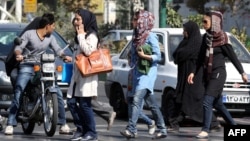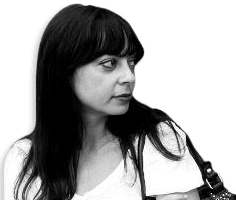If you are celebrating the sacred month of Muharram in the Islamic republic, you best not make it a fashion statement.
Amid reports that some hair salons and barbers have been advertising "special Muharram" styling to lure clients, warnings have been issued against the practice of shaving the words "Ya Hossein" into peoples' hair.
Also out is the wearing of garish makeup, T-shirts, and leggings during Muharram, which honors the martyrdom of Imam Hossein -- the grandson of the Prophet Muhammad.
The warnings against hairstyles bearing Hossein's name, issued by the heads of the country's associations of barber shops and hair salons following the beginning of the sacred month on October 15, come amid reports in conservative media about the rise of Muharram fashion.
The head of Iran's barbers union, Mostafa Govahi, warned specifically against shaving the name of Imam Hossein, who was slain in a battle in Karbala in 680 and whose martyrdom is commemorated by believers during Muharram.
"The so called special Muharram makeup and hair designs that have become popular in the society is an insult to religion," Govahi was quoted as saying by Iranian media earlier this month. "We will deal with it."
Govahi also noted that plucking eyebrows, tattoos, and the use of lipstick were among measures that could lead to the closure of barber shops.
The head of the association of Iran's hair salons issued a similar warning.
Afsarolmoluk Sayan is quoted by Iranian news sites as saying that "special Muharram makeup" and related advertisements are banned, and that salons that offer such services would be reprimanded.
"A text has been sent to salons that fall under the association, warning them about legal action, and a notice was also published in newspapers," Sayan was quoted as saying on October 15.
Sayan did not elaborate on the kind of makeup that is used during Muharram rituals -- which include singing, passion plays, and chest beatings in mosques and on the street -- that reach a peak on the ninth and tenth day of Muharram known as Tasua and Ashura.
Tighter, Shorter Clothes
However, a conservative website offered some details in a story about the "strange appearance of the youth in Muharram."
"Lips turned red, blond hair, short scarfs and shawls, along with supports [i.e. leggings] that are sometimes inscribed with 'Ya Hossein' are among [the highlights] of this year's Muharram's nights," Shafaf.ir reported on October 18.
"In fact, the times when barbers shops and hair salons would close to respect the mourning rituals of Imam Hossein, have come to an end," the report noted.
The website quoted a 30-year-old hairdresser in Tehran, identified as Mina, as saying that, in the past five years, Muharram fashion has become quite popular in the Iranian capital.
"Young girls want us to put makeup on their face that is appropriate for the evening, even hair colors that are brighter and can be seen at night become fashionable and in demand," Mina said.
Artist Sima told the website that two weeks prior to the month of Muharram, young Iranians place their orders to have the name of Imam Hossein inscribed on their clothing.
"Young women, even young men, come to me to have 'Ya Hossein', or parts of well-known dirges inscribed on their manteaux, t-shirts, and shawls," the artist told Shafaf.ir.
The Azad news agency (ANA) quoted Massumeh Mahmudian, the manager of a hair salon in the Iranian capital, as saying that there was "a new wave" among some Iranians requiring special makeup for Muharram.
"We don't have the right to ask our clients what they do with such makeup, we haven't been told that such activity is banned in the month of Muharram," she said.
A report in Ion.ir said disapprovingly that some of those attending Muharram rituals were dressed as if they were going to a wedding.
The report added that it has become a common scene in recent years for women and girls with heavy makeup and hair dyed blond to come onto the streets to watch Muharram rituals without sincerely mourning.
"In recent years Muharram has become an excuse for some to hold night carnivals and wear inappropriate clothing and makeup, "the report said.
Since the creation of the Islamic republic, authorities have attempted to control all aspects of citizens' life, including their appearance.
Women have fought back by gradually pushing the boundaries by showing more hair and wearing tighter and shorter manteaux.






